Berry, Johnny
Posted: Friday 29th May 2020
Johnny Berry was a Manchester, U.K. bicycle frame builder of top repute (See Figure 1). During a 42-year career that spanned the important decades of lightweight development and refinement, Johnny Berry made about 1,400 frames, first under the Berry & Bentley name and then under his own. Berry built to a high standard. His frames had a good reputation, performed well, and had a recognizable style. Berry’s best frames show enormous attention to detail and are beautifully done; he spent a long time on each one.
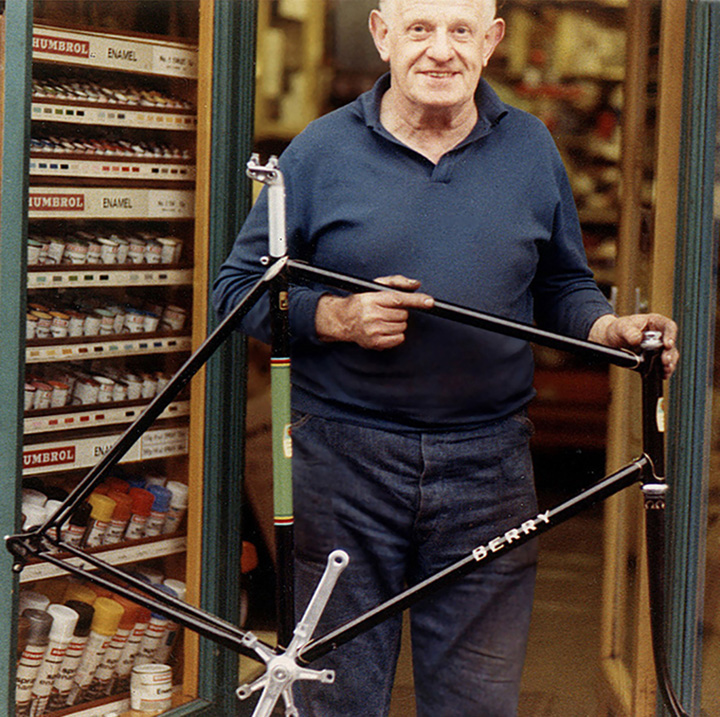
Berry was an avid cyclist and an active member of the Manchester Wheelers. He joined the club in either 1927 or 1928, competed in time trials through the early 1940s, organized races, led club rides, and served as president in 1950 and 1960 (6, 19, 23). Through cycling, he met his future business partner, Bill Bentley of the Cheshire Roads Club (8).
Circa 1933, Johnny Berry and Bill Bentley opened a cycle shop at what is now 4, 5, and 6 Wilmslow Road, Rusholme, Manchester, UK (11). Bentley managed the shop. Berry focused on frame building, skills that he had learned in the Manchester area from Tim Heeley (frame builder at Stenton Glider and, later, Heeley Lightweight) (8).
At least 471 Berry & Bentley frames were built by Johnny Berry from circa 1933 until the mid 40s. Early examples strongly resembled Stenton Glider frames (26). Today, only a few Berry & Bentley frames are known to survive (8, 18). Of the twelve Berry & Bentley frames that the authors have seen, all have side attached seat stays with the attachment point low on the seat lug (18). The bulk of Berry & Bentley frames were made between when the shop opened and the onset of World War II. During the war, Berry was only able to build a few frames while working at the British Oxygen Company in a reserved occupation (8).
Berry & Bentley frames had a serial number stamped on the left dropout. Forks had a corresponding serial number; at first the numbers were stamped on the steerer tube and later under the fork crown (11). From circa 1933 to 1937, frames and forks were stamped only with a frameset number which served as the serial number (8). Frameset numbers ran sequentially from when Johnny Berry began building Berry & Bentley bicycles. The last frame that we have seen with just a sequential frameset number acting as its serial number is frame number 271; it was probably built in the first half of 1937. By 1938, Berry & Bentley frames were stamped with 5-digit serial numbers; a 2-digit date code (e.g., “38” = 1938) preceded the sequential frameset number. Thus, the 471st Berry & Bentley frame, built in 1943, carried a serial number of “43471”; it was reportedly built for Bill Bentley (22) and is the last known Berry & Bentley frame (18).
In 1946, Johnny Berry and his wife, Ida, opened their own cycle shop and lived above it with their son, Donald (see Figure 2). In the May 8, 1946 edition of Cycling, Johnny Berry announced the new store’s address, “149 Wilmslow Road, Rusholme, Manchester, 14 (opposite Claremont Road)”. The shop’s address was later renumbered by the Manchester City Council, becoming “193 Wilmslow Road” (11); evidence suggests that the renumbering happened in the early 1950s before mid 1952 (24, 27). Johnny Berry built his frames in the shop. Typically, Ida Berry worked there. Periodically (especially during peak times) others were hired to file lugs and to help out (8, 19). Sales from the frame business and cycle shop supplemented each other, allowing Berry to spend more time on a frame than other builders who built on a piece rate (4). Frame building also added prestige and business to the shop.
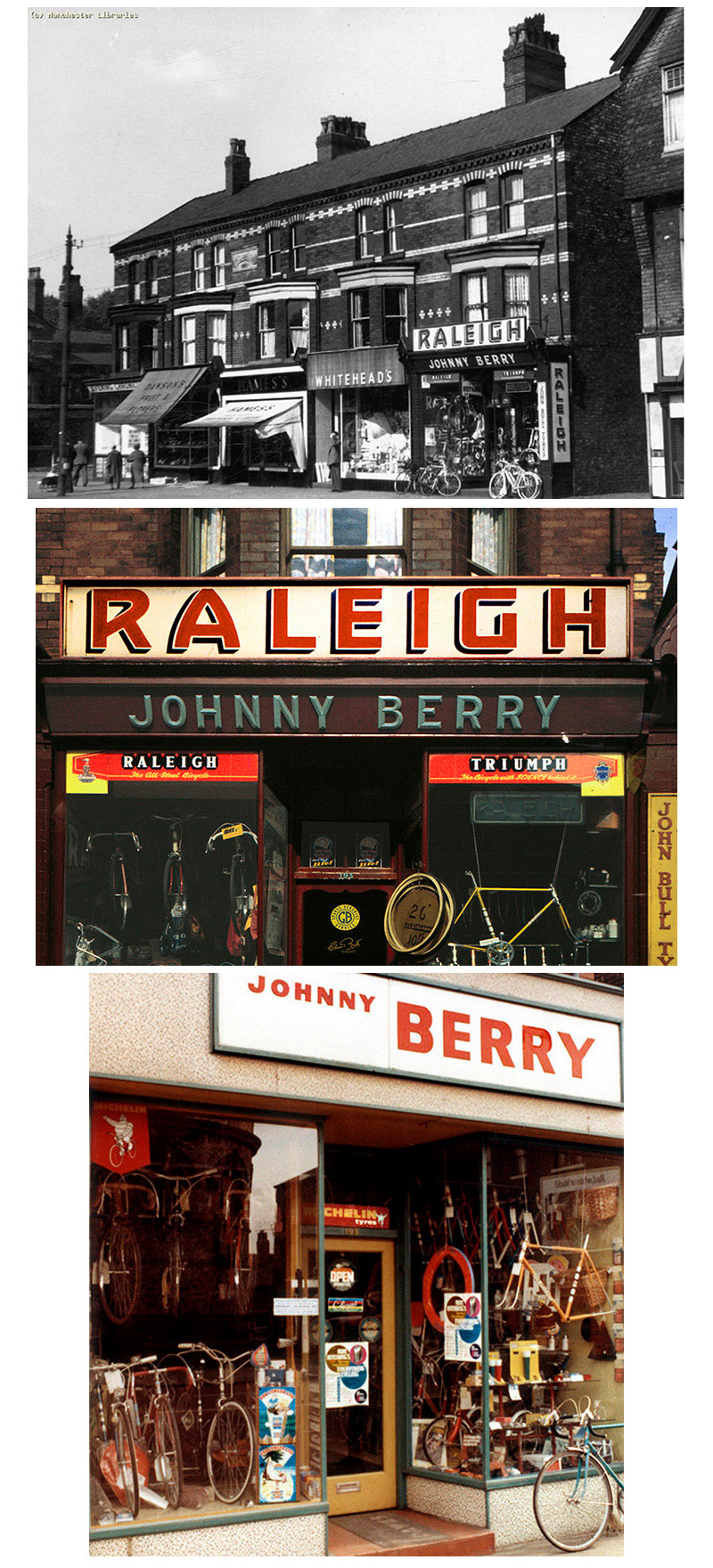
Johnny Berry and Ron Kitching attended the 1946 Paris cycle show together, associating with members of the French cycling trade, including André Bertin and Raymond Fletcher of C.N.C. Cycles (14). While in Paris, Kitching asked Berry to join him in a business venture importing cycling goods into Britain, but Berry declined (14). Kitching later became one of the largest and most influential importers and exporters of cycling equipment in the world. In 1947, Johnny Berry was back in Paris again, acting as unofficial mechanic for clubmate Reg Harris at the UCI Track Cycling World Championship; at this race meet, Harris won the World Amateur Sprint Championship, Britain’s first world cycling championship in a quarter of a century (6). The connections that Berry made with the cycling community in France were to continue in later years; co-author Alan Woods remembers Ida and Johnny Berry mentioning their French contacts during his visits to their shop in 1971 and 1972.
913 frames were built by Johnny Berry under his own name between 1946 and his death in 1974. For 28 years, Berry built frames in the ground floor workshop behind the display area of the shop (4). His last frame, #741913, is now in the collection of MOSI (Museum of Science and Industry, Manchester), where it joins three other Johnny Berry bicycles/frames that were built in 1942, 1951, and 1973, and a 1934 Berry & Bentley track bike. MOSI permanently closed their bicycle exhibit a couple of years ago; contact the museum curator to privately view the stored bicycles.
Johnny Berry made many of his own tools and jigs, but other tools were fabricated for him, including shaped and hardened mitering blocks (4). Tools and equipment became more sophisticated as Berry’s career progressed and his needs changed; older, less refined tools were found retired in his workshop after the shop closed (4).
Typically, serial numbers on Johnny Berry framesets were composed of 6 digits, but a few frames and/or forks were stamped with a “0” before the normal 6-digit serial number. We know of no duplicate Johnny Berry serial numbers. A 2-digit date code (e.g., “58” = 1958) always preceded a distinctive “1” which was followed by a 3-digit frameset number (e.g., 656). We know of no duplicate frameset numbers. Frameset numbers ran sequentially from when Johnny Berry began building under his own name in 1946 (8). For example, the 656th Johnny Berry frame, completed in 1958, carried a serial number of “581656”.
Earlier date codes usually correspond with lower 3-digit frameset numbers, but there are quite a few exceptions. For example, one frame with a 1951 date code has a frameset number that is lower than several known frames stamped with a 1950 date code (18). We believe that the root cause of this inconsistency is that Johnny Berry assigned the date and the frame number independently and at different times. The 3-digit frameset number was, we believe, assigned when the order was booked or when the frame was started. The 2-digit date code was stamped on the frame and fork later, during the building process (13, 29). The year of delivery and the stamped date code do not necessarily correspond; the date code could be earlier than the year of delivery. Any delay in a frame’s progress, whatever the cause, would increase the chances of a frame being stamped with a later date code than undelayed frames with adjacent frame numbers .
A serial number was stamped on the frame and fork of every Johnny Berry bicycle. The serial number on the fork matched the one on the frame; nearly always the correspondence was exact, but one fork is known to have a “0” preceding the serial number that appears on the frame. Forks were always stamped with a serial number under the fork crown. Frames carried a serial number on either the left dropout or under the bottom bracket. From 1946 to early in 1953, the serial number on a Johnny Berry frame almost always was stamped somewhere on the outside of the left dropout, typically on the front part of the web above the wheel slot or behind the wheel slot (see left photo in Figure 3). The only exception that we know of is a 1948 tricycle that lacks traditional dropouts; its serial number was stamped under the bottom bracket on the drive side. After early 1953, serial numbers were stamped under the bottom bracket shell (almost always on the drive side) (see right photo in Figure 3). The change in the position of the serial number roughly corresponds with Berry’s gradual adoption of Campagnolo horizontal dropouts for use on road frames; we have never seen a Campagnolo dropout stamped behind the wheel slot with a Johnny Berry serial number.
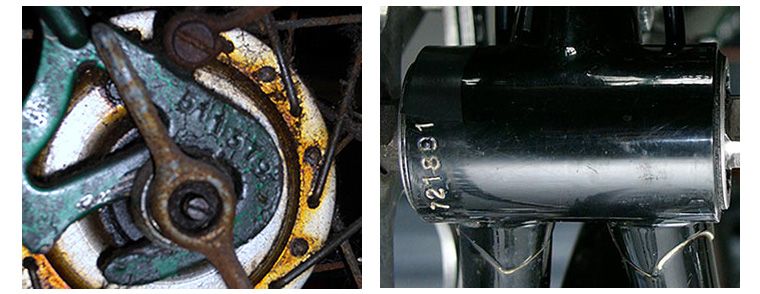
Berry built frames only to special order. The waiting time from the late-1940s to the mid-1950s was often 1.5 to 2 years (8, 9). The period between order and delivery was still a year in 1960 (9) and 8.5 months in 1971 (see Figure 4) (13). After 1960, when many British builders closed shop, Berry continued to excel as a frame builder, remaining dedicated to his craft (1, 4)
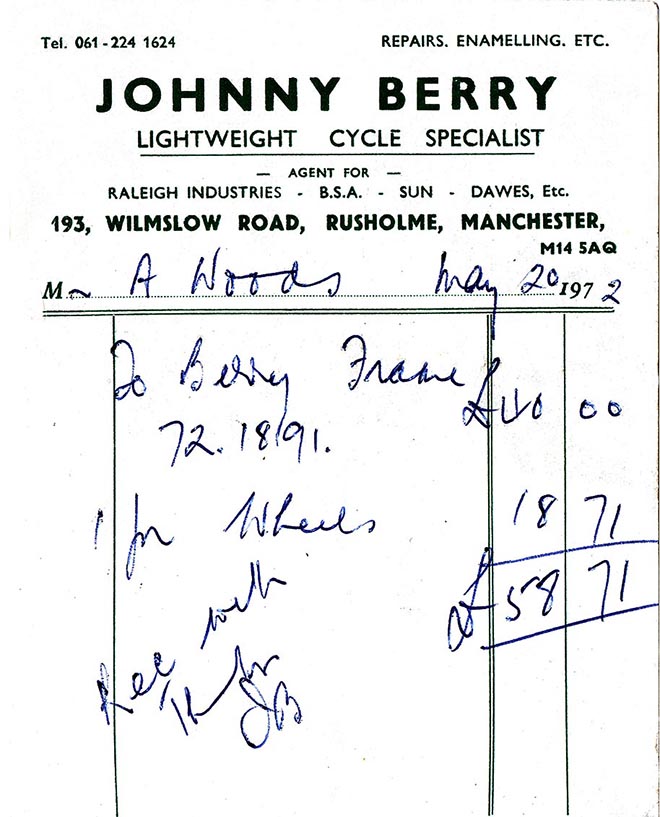
Johnny Berry frames (1946 through 1974) tend to share the following qualities or features:
- Serial numbering was distinctive. Always, a “1” was the fourth digit when reading from the right. Typical serial numbers had six digits and always began with “4”, “5”, “6”, or “7”. Matching serial numbers were stamped under the fork crown and either under the bottom bracket shell or on the left dropout.
- Lugwork was thinned and tapered; it featured clean, precise shore lines (11). Fork crowns were reworked and well finished.
- Flat fork crowns were typical on road bikes with oval blades. Twin plate fork crowns were used on track and road/path bikes with round fork blades.
- Wrap-over seat stays capped by flat top-eyes were typical after 1951. Side-attached seat stays were common from 1946 until 1951; attachment point was low on the seat lug until 1947, but, thereafter, became higher.
- Bulge-formed Raccords Gargatte Freres bottom bracket shells were typical on frames with Prugnat or Oscar Egg Super Champion lugs; each is stamped on the top left side with “RGF” inside an oval border. Nervex bottom bracket shells were used on some frames built with Nervex lugs.
- Domed stay ends and domed blade ends were used on about 65% of framesets. A third had domed stay ends mixed with scalloped blade ends. 5% had scalloped stay and blade ends. After 1963, scalloped ends were rarely used (18).
- A circular, stop with “V” groove was brazed onto the top of the down tube on 70% of road frames after 1960 (see Figure 5); it prevented clamp-on shifters or bar-con housing stops from sliding or twisting.
- Forward facing, horizontal dropouts were used on nearly every road bike. The Campagnolo 1010 dropout with integral derailleur hanger appeared by 1953 and became typical after 1957 (18). Stallard, Simplex and Agrati dropouts (with or without gear hanger) were used on early frames.
- Grease nipples were typically fitted to road frames. From 1946 to 1969, 95% of frames had at least one, on the left side of the lower head lug and/or on the bottom bracket shell. After 1970, grease nipples became less common (18).
- Brake calipers were almost always attached to the fork and/or frame via a center bolt (18).
- Straight brake bridges were used on about 90% of frames before 1958, and on all frames that we have seen after 1968. Between 1958 and 1968, curved brake bridges were popular, appearing on about 75% of frames.
- Dropouts were spaced at 120mm on derailleur-equipped bikes. Berry never used 126mm spacing because cog overhang and extreme wheel dishing could lead to premature bearing and wheel failure (21).
- Top eyes on original bikes built after circa 1957 carried a distinctive painted decoration consisting of parallel, brush-applied lines, the signature of C & G Finishes, Liverpool, Berry’s longtime painter (see Figure 5).
- Frames without chrome were typical. Only about 15% of the framesets that we have seen have chrome on stays, blades, forks, and/or crowns (18).
- Brake cable housing stops on the top tube of road bikes were usually brazed on. From 1946 to 1969, about 85% had them; typical were “D”-shaped stops brazed onto the right side of the top tube at the 5 o’clock position. Beginning circa 1958, diver’s helmet stops appeared and were often positioned on or near the top of the top tube; later they became increasingly popular. In the 1970s, clamp-on brake cable stops increased in popularity, but braze-on brake cable stops were still found on about 60% of frames (18).
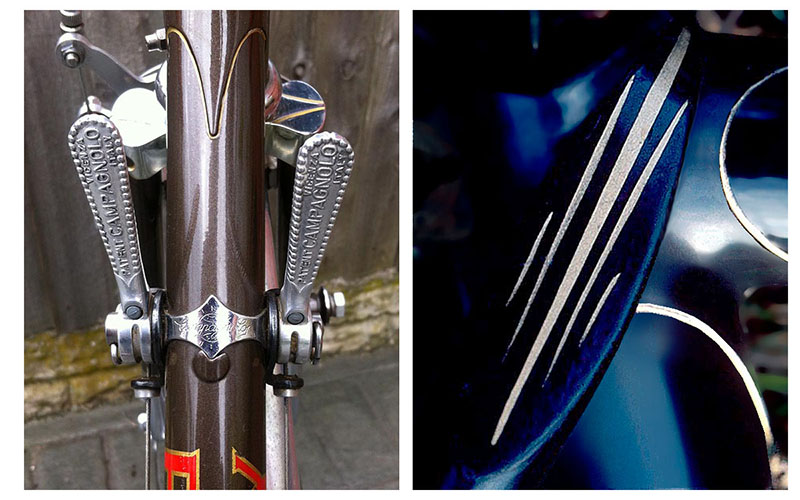
There was a general progression in lug styles used on Johnny Berry framesets through time. During any one era, there was a fairly consistent use of one lug style. However, there was some limited style overlap during transitional periods. Most frames from 1950 through 1957 were built with Oscar Egg Super Champion lugs (Figure 6 A1), but the same lug set was sometimes used on later frames, including ones built in 1958 and 1961, and early versions of the lug were used as early as 1949 (18). From about 1958 through 1960, most Berry frames were built with Nervex Professional lugs (see Figure 6 A2), but the same lug set was found on a few later frames, including one built in 1963 (18). The first Berry frames with Nervex Professional lugs appeared in late-1956 or 1957. From 1961 through 1974, nearly all frames were built with plain cut, long-point Prugnat Type-S lugs (Figure 6 A3); the earliest Berry frame with Prugnat Type-S lugs that we know of was built in 1961 (18). Although a general progression of Berry lug styles is evident from the record, it is also true that he built to order, so interesting style variations do occur. One of the most unique is Johnny Berry’s beautifully crafted display frame featuring fretwork and fleurs-des-lis; it hung in his shop for many years, was originally green, but is now burgundy (Figure 6 B1). Berry also made a few frames with Prugnat 62/S lugs, including a 1969 road frame (Figure 6 B2).
The crown type used on Johnny Berry forks varied by bicycle type and through time (see Figure 7). Track and road/path frames with round fork blades had twin plate (or twin-plate-look) fork crowns (Figure 7 A1, A2). Johnny Berry road frames with oval blades, except very early bikes, typically had flat-top fork crowns made by Ekla or Vagner. From 1947 to 1952, Berry usually used drop forged Ekla fork crowns (various models) on road bikes (Figure 7 B1), but a few Vagner crowns were used as early as 1951. By 1953, Berry was well into his transition to forged Vagner fork crowns, although a few frames continued to be made with Ekla crowns through 1954. From 1955 to 1961, Berry used Vagner fork crowns on about 85% of his framesets; 75% of these Vagner crowns featured a fish mouth decoration on each side that nicely mimicked the swirls of Oscar Egg Super Champion head lugs (Figure 7 C1) (18). After 1961, Berry commonly used the Vagner DP fork crown on his road bikes (Figure 7 C2); about 75% had a Vagner DP crown, about 15% had a Vagner crown with a medium spearpoint side decoration (Figure 7 C3), and 10% had a Vagner crown with a fish mouth decoration (18). Of the Vagner crowns that we have seen, nearly half have chevrons on the shoulders (Figure 7 C2) (18). Nearly all Johnny Berry fork crowns have a flat top; we have seen only two Berry forks with semi-sloping, Bocama crowns, one built in 1961 and the other in 1969. Although there is a general progression of Berry fork crown styles through time, it is also true that interesting and, sometimes, very special variations occur (Figure 7 D1, D2).
Almost all Johnny Berry road and road/path frames were built so that caliper brakes could attach to the brake bridge and fork crown via a center bolt; we know of only one original frameset with braze-on brake bosses (18). Between 1946, when Johnny Berry started building under his own name, and 1974, when he died, about 85% of his road and road/path frames were built to accept side pull brakes. However, between 1963 and 1970, when center pull brakes were especially popular, about half of Berry’s road and road/path frames were specifically built to accommodate center pull brakes (18). These frames for center pull brakes had a sturdy brake cable housing stop brazed across the seat stays; typically, the rear brake cable housing stop was composed of a drilled, arched tube (see Figure 8). It was located above the rear center pull brake caliper and its straddle cable.
Gear lever bosses (or a single boss) were brazed onto the down tube of about 35% of road frames (18). Bosses were Simplex-style before circa 1957 and Campagnolo-style afterwards. Campagnolo-style shifter bosses on pre-1958 frames are a sign of frame modification.
A few, usually special, framesets were stamped with the maker’s name, “BERRY”, in small, san-serif, capital letters (see Figure 8). About 5% of the frames that we have seen bear this maker’s mark. Usually, it is stamped somewhere on the fork crown, but it also can be found elsewhere, such as on the left dropout, under the bottom bracket shell, or on a cap brazed to the bottom of the steerer tube.
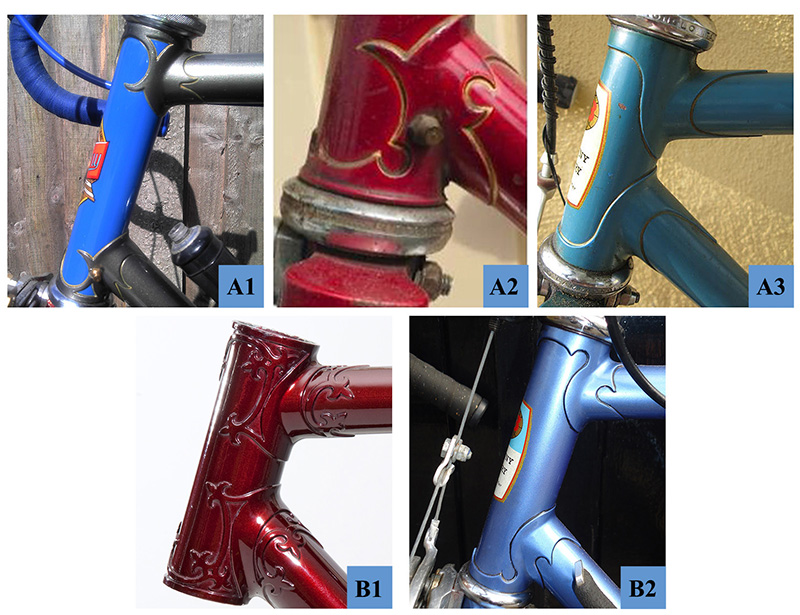
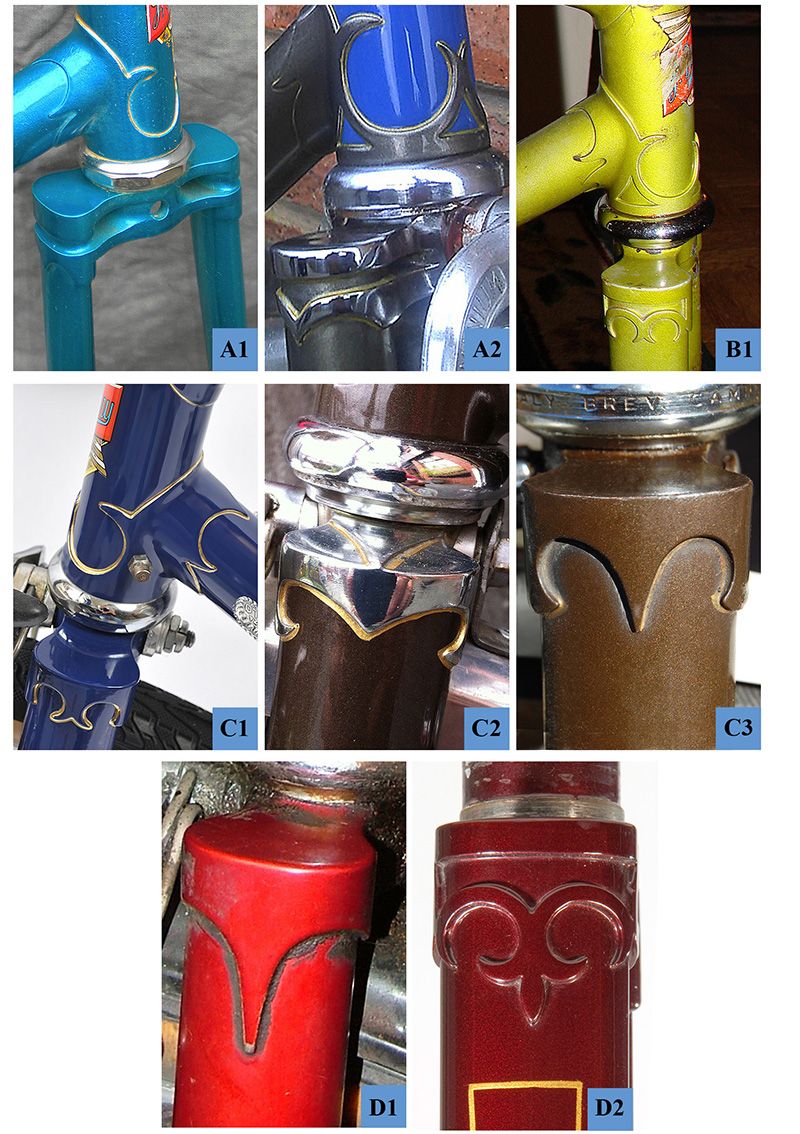
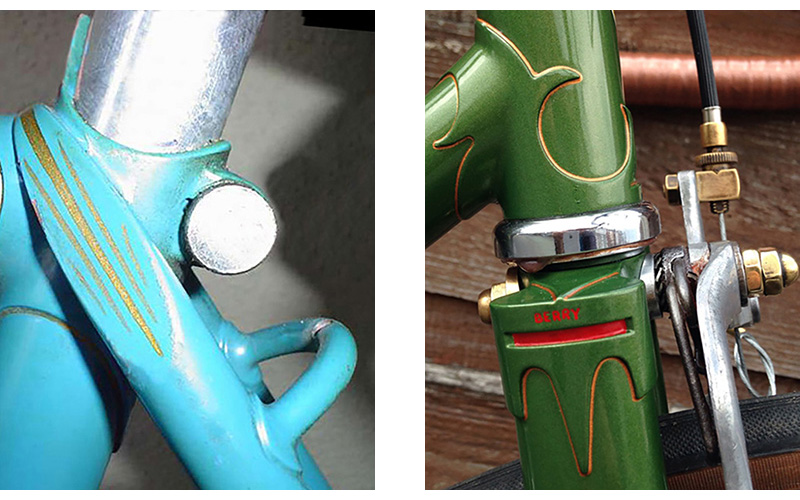
Several styles of down tube transfers were produced for Berry (see Figures 9 and 10). Style 1 was exclusively used on Berry & Bentley frames. Styles 2 through 6 were for frames that Johnny Berry built under his own name. Style 2 was used only on early Johnny Berry frames, Style 3 appeared by 1948, Style 4 by 1957, and Style 5 by 1961. Style 6 might have been intended primarily for track frames, but was rarely, if ever, used; of all lettering styles, only Style 6 is outlined in two contrasting colors. Styles 3, 4, and 5 of Johnny Berry down tube transfers were produced in various colors and were outlined by a single contrasting color. Overall, Style 3 was the most frequently used down tube transfer, but Style 5 was also widely used. After the mid 1960s, Style 5 adorned at least two thirds of the frames and Style 3 accounted for most of the remainder. Style 4 was not used as often as Style 3 or Style 5 (18).

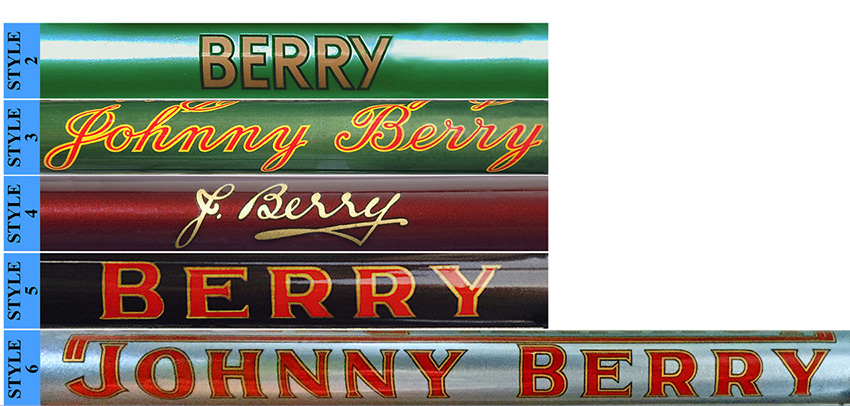
Three styles of badge transfers were applied to the head and seat tubes of frames built by Berry (see Figure 11). The Style A badge was used exclusively on Berry & Bentley frames; it was always paired with Style 1 down tube lettering. Two different badge transfers were used on the seat and head tubes of Johnny Berry frames, Style B and Style C. Style B had two address variations (11), “149 Wilmslow Rd.” from 1946 to about 1952 and, later, “193 Wilmslow Rd.” (24, 27). The Style B badge was normally paired with Style 2, Style 3, or Style 4 down tube lettering. The Style C badge was introduced in 1961 as an alternative to Style B (11); it was usually paired with Style 5 down tube lettering. Badges almost always were in the form of a transfer, although metal Johnny Berry head badges were manufactured (11). Both brass and aluminum badges were produced, possibly in more than one style. The authors know of only one Johnny Berry frame (a 1952 tricycle) with a metal badge still riveted to the head tube (see Figure 11). Originally, the metal badge may have had a painted (red and green or red and black) background with bare metal letters exposed (11).
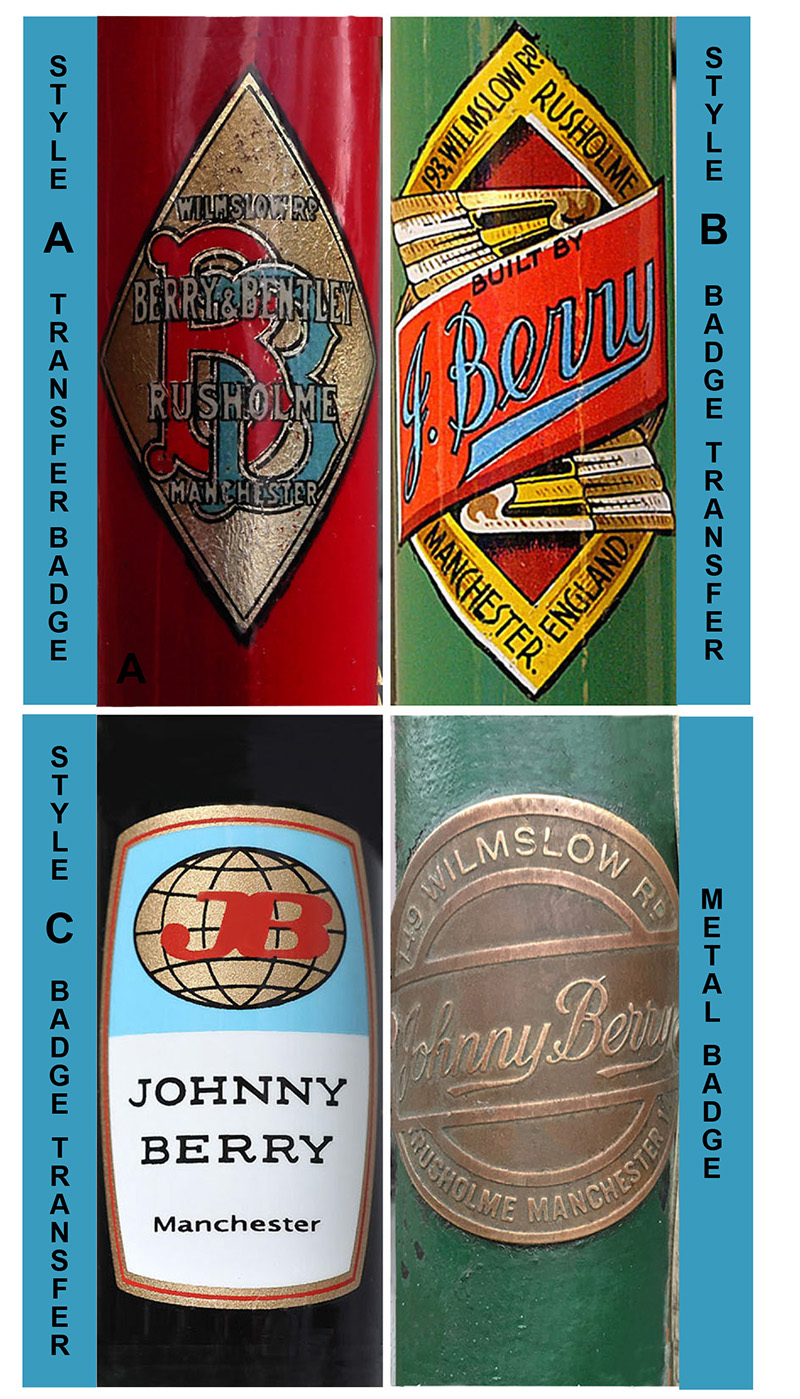
Most styles of transfers are available today. Original, varnish transfers can still be sourced and can be viable even though they are over 40 years old; however, they must be applied carefully by a skilled restorer because they are prone to tearing and may not be stable under modern clear coats. Reproduction transfers are also available; five styles of down tube lettering and three styles of badges have been reproduced. However, no Style 6 down tube transfers and no badges bearing “149 Wilmslow Rd.” have been reproduced. Berry & Bentley reproduction graphics are available in cut vinyl from World Cycle Decals via bicycledecals.net. Johnny Berry reproduction decals can be sourced in cut vinyl from bicycledecals.net and from H. Lloyd Cycles in Loughton, Essex, UK. Johnny Berry reproduction transfers (down tube lettering Style 5 and badge Style C) can also be sourced as dry-fix (i.e., rub-on) transfers in three different color combinations from SSSink in West Jefferson, N.C., USA.
The vast majority of Berry’s frames were purchased by cyclists and club riders from the Manchester area (especially members of the Manchester Wheelers) (8). Berry also had customers throughout Britain and abroad. Among Johnny Berry’s most famous customers were racers Brian Robinson (25) and Audrey McElmury (15, 17). According to Ron Kitching, Berry also built frames for Reg Harris (Johnny’s friend, clubmate, and track champion) (14), but this has not been verified.
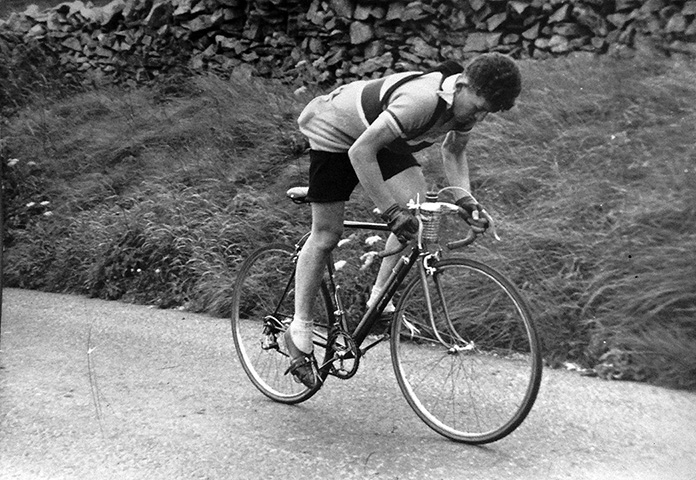
In the early to mid 1960s, export opportunities for cycles were strong at a time when British demand was tapering off. One part of the United States, southern California, accounted for at least 3% of Berry’s total production after 1960; co-author Alan Woods knows of seven frames that were built for customers in the area, but there could have been more (18). Possibly the first Berry frame in southern California was built for Harry Backer (16); he was a member of the 1952 U.S. Olympic track team in Helsinki (12). Other frames were built for Jerry Rimoldi, the co-founder of the San Diego Bicycle Club and proprietor of College Cyclery in San Diego. Rimoldi was the 1972 U.S. Olympic Track Cycling Coach in Munich (5). Johnny Berry and Jerry Rimoldi knew each other, sharing the common experience of being official mechanics at the Olympic Games, Berry in 1948 for the British cycling team in London and Rimoldi in 1968 for the U.S. team in Mexico City (5, 6, 8). Rimoldi helped introduce competitive cycling and Johnny Berry frames to San Diego-area cyclists, including his friends Scott and Audrey McElmury (16). Scott McElmury ordered a custom track frame from Berry when he visited Manchester in the summer of 1963 during a cycling tour organized by Dr. Clifford Graves, founder of the International Bicycle Touring Society; in spring, 1964, Scott’s new frame arrived in San Diego (7). In 1965, Audrey McElmury ordered a Berry road bicycle from Jerry Rimoldi at College Cyclery in San Diego (7, 15, 16).
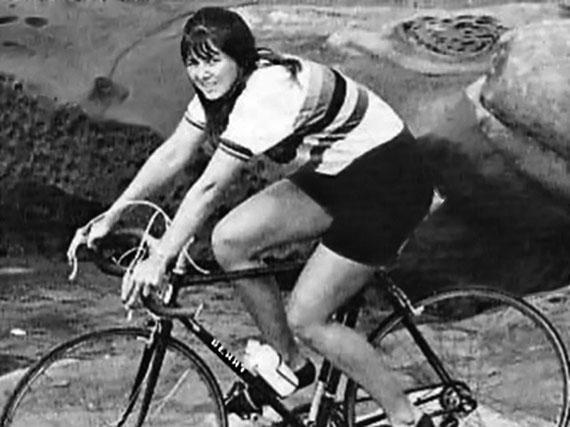
Audrey McElmury was a smooth, powerful, world-class rider (see Figure 13). Although, McElmury was twice the U.S. National Road Champion and had won several National Track Championships, she emphasized international competition over national (17). McElmury raced at nearly every world championship from 1965 through 1973. In 1969, she rode her 1966 Johnny Berry bicycle to solo victory in rainy, difficult conditions on a hilly circuit at the women’s UCI Road World Championships in Brno, Czechoslovakia (2, 10). It was America’s first world road cycling championship, and only the second world cycling championship that the USA had ever won (2). Johnny and Ida Berry were very proud of Audrey McElmury’s world championship victory and mentioned her each time co-author Alan Woods visited their shop in 1971 and 1972. Some of Berry’s later frames were adorned with rainbow stripes on the seat tube in recognition of Audrey McElmury’s World Championship victory, including road bike #721891 (see Figure 1). Alan Woods ordered #721891 from Johnny and Ida Berry at their Manchester shop in September, 1971. Eight and a half months later, Alan Woods picked up his finished bike from Berry’s shop (see Figures 1 and 4).
Co-author Alan Woods first heard about Johnny in 1970 from Lee Marshall who resided in Long Beach, California, USA, his home town. Marshall mentored young riders in southern California and raced at the Encino Velodrome where Audrey McElmury set her 1969 National Hour Record.
The production rate during Berry’s 42-year career averaged about 33 frames per annum, but varied from decade to decade and from year to year. Before World War II, he built about 50 Berry & Bentley frames per year (8). During the war, Berry’s annual production volume was much lower. Exactly (or even approximately) how many Berry & Bentley frames he built during the war is not known because the serial number record is incomplete; the last Berry & Bentley frame that we know of, #43471, was built in 1943, well before the end of World War II (18). After the war, Johnny Berry resumed significant production, this time under his own name. From 1946 to the end of 1958, Berry produced approximately 687 frames, averaging about 53 frames per annum. His busiest year during the 1946 to 1958 period was in 1951 when he built at least 90 frames, and, quite possibly, over 100. Production tailed off as the 1950s progressed. By 1959, Berry produced less than 12% of the number of frames that he built in 1951. On the serial number record that we keep, there are 27 frames from the 1960s and 14 frames from the 1970-1974 period. Presently, data point resolution is sufficient to report that Berry built between 50 and 56 frames from the beginning of 1960 to the end of 1961 and that 17 frames are stamped with a 1962 date code (18). Berry’s production rate fell later in his career. Approximate average annual production from 1963 to 1969 was somewhere between 12 and 15 frames (18). Approximate average annual production from 1970 to 1974 was somewhere between 8 and 12 frames per year (18).
No Johnny Berry build book survives that contains a comprehensive list of serial numbers, dates, customer details, and specifications. As a result, it is not possible to directly calculate how many frames Berry built each year from 1946 to 1974. Instead, annual production rates have to be estimated from the serial numbers of known frames, using their 3-digit frame numbers and 2-digit date codes as reference points. Presently, 89 Johnny Berry frames are on the serial number list that co-author Alan Woods has compiled with the generous help of others, especially co-author Rick Hart. This is 9.7% of the total number of frames (913) that Johnny Berry built under his own name from 1946, when he opened his shop, until his death in 1974 (18). Many gaps occur in the Johnny Berry serial number record (18). As a result, most of our estimates of annual production have to be expressed as a range of possible rates, instead of as a specific rate. The range in these estimates of annual production will narrow as more frames become known, filling gaps in the serial number list. We have excluded from our estimates serial number outliers and any frame whose frameset number overlaps that of another frame bearing a different date code. This has been done to ensure that production rate estimates have not been artificially inflated by anomalous serial numbers.
In December, 1974, Johnny Berry died at the age of 66 (8). His frame making tools and equipment went to other builders after his death. Today, Berry’s 3 x 4’ alignment table and his bench vise are main features of Doug Fattic’s frame building workshop/classroom in Niles, Michigan, and are used regularly (4). Gordon Blaikie is the Veteran-Cycle Club (V-CC) Marque Enthusiast for Cheshire, Manchester, and Merseyside Cycles.
Updated and Revised: July, 2020
Footnotes:
(1) Stevenson, W.D., frame builder in Olympia, WA., 2011-2016, Written personal communication with Alan Woods.
(2) Nye, P., 1988, Hearts of Lions, History of American Bicycle Racing: NY, Norton, pp. 208-231.
(3) Thompson, Corey, frame builder in Olympia, WA., 2011-2016, Written personal communication with Alan Woods.
(4) Fattic, Doug, frame builder-teacher in Niles, MI., 2007, 2010, 2013-2016, Written personal communication with Alan Woods.
(5) USA Cycling website. See: www.usacycling.org/news/user/story.php?id=113
(6) Barlow, T.M., and Fletcher, J. compilers, 1983, A History of Manchester Wheelers’ Club 1883-1983: Manchester. Pdf available from: www.manchesterwheelers.uk/history
(7) McElmury, Scott, 2007, The Great European Tour: Bicycle Quarterly, v. 6, no. 2, pp. 1, 11-14.
(8) Sant, R. (and unnamed contributors), 2002, Made in Manchester – Part IV (Johnny Berry): The Northern Wheel – Manchester and District CTC, pp. 63-65.
(9) Letter from Jim Batty to Toni Theilmeier, as reported on p. 9 of Theilmeier, T., 2006, Johnny Berry: The Boneshaker – Journal of the Veteran Cycle Club, v. 170, pp. 8-13.
(10) Wilcockson, John, 2005 (April 1), Inside Cycling with John Wilcockson – World firsts, VeloNews. See velonews.competitor.com/2005/04/news/inside-cycling-with-john-wilcockson-worlds-firsts_7788
(11) Blaikie, Gordon, 2013, Johnny Berry Dating: News and Views – Newsletter of the Veteran-Cycle Club, no. 354 (April/May), p. 43.
(12) San Diego Velodrome Association history. See www.sdvelodrome.com/history.htm
(13) Frame #721891 was ordered in early September, 1971 by co-author Alan Woods and delivered 8.5 months later on May 20, 1972 at Berry’s Wilmslow Road shop (see Figure 4 for receipt).
(14) Kitching, Ron (edited by Michael Breckon), 1993, A Wheel in Two Worlds – The Ron Kitching Story: published by Ron Kitching, p. 101 and pp. 141-142.
(15) Maloney, Tim, 2013 (April 21), Racy Language: In Memorium – America’s First Women’s World Champ: Road Bike Action Magazine. See www.roadbikeaction.com/Racy-Language/content/316/6672/Racy-Language-In-Memorium-Americas-First-Womens-World-Champ.html
(16) McElmury, Scott, Templeton, CA., 2013, Written personal communication with Alan Woods.
(17) Sunderland, Sandra Wright, 1995, No Brakes! Bicycle Track Racing in the United States – chapter 4 mini history “America’s first World Champion since 1912 – Audrey McElmury”: Encinitas, CA, Iris Press, pp. 55-57, and p. 273.
(18) Based on a serial number data base compiled by Alan Woods with the generous help of others, especially co-author Rick Hart, containing information on 101 frames built by Johnny Berry, including 12 labeled as “Berry & Bentley” and 89 labeled as “Johnny Berry”.
(19) Theilmeier, T., 2006, Johnny Berry: The Boneshaker – Journal of the Veteran Cycle Club, v. 170, pp. 8-13.
(20) Horton, Shelly and Brett with text by Owen Mulholland, 2006, Cycling’s Golden Age – Heroes of the Postwar Era, 1946-1967 -The Horton Collection: Boulder, Colorado, Velo Press, pp. 186-187.
(21) Berry, Johnny, frame builder in Manchester, UK, September 15, 1971, Written personal communication with Alan Woods.
(22) Whitehall, Sy, UK, 2015, Written personal communication (source: John Swift) with Alan Woods.
(23) Undated. “Presentation of Life Membership Plaques” invitation. Contains list of members of Manchester Wheelers along with their joining dates.
(24) The last reference to the “149 Wilmslow Road” address that we know of was on the letterhead of a receipt dated July 21, 1951 for Johnny Berry frame #511377. The last known frame with a head badge bearing the old address was tricycle #521430 that was built in mid 1952.
(25) Fife, Graham, 2010, Brian Robinson: Pioneer: Mousehold Press, 237 pp.
(26) Harries, David, UK, 2016, Written personal communication with Alan Woods.
(27) The first appearance of the “193 Wilmslow Road” address that we have seen was on the head tube transfer of unrestored Johnny Berry frame #521459 that was finished in the second half of 1952.
(28) Manchester City Council. Local Image Collection. See: https://images.manchester.gov.uk/index.php?session=pass and search for image: m42148.
(29) Frame #681839 was ordered in October, 1968 and delivered 7 months later on April 12, 1969.
I have just been reading the Johnny berry section and it reminded me of something Frank Herety told me many years ago, if I remember correctly Frank used to work for Johnny years before and learnt his skills as a frame builder from him, Frank also continued to use C & G finishes in Liverpool and also used the same lug detailing and paint touches such as the seat stay cap lines.
My own Frank Herety bike was one of the last he made and has the same detailing as seen on Johnny’s frames. Frank was desperately trying to stop making frames during the early 90’s due to lung problems from inhaling brazing fumes etc and would only make one when in the mood, I asked for years with no success until one day he phoned me and said “do you still want one of my frames” I was at his shop before the phone rested back on the hook for measuring up.
Frank also made frames for Ribble (look for the frame #, if it has FH stamped on it, then it’s one of Frank’s, it’ll probably have internal cable guides too) he also made excellent wheels that didn’t need a service to re-tension the spokes because Frank had a way of stress relieving them and then re setting the correct tension before you were given them to ride. Both men very skilled in many ways.
I am a keen cyclist and so was my father. I have his 1939 Berry and Bentley cycle frame, frame no. 39.360, which I eventually want to restore. He was a cycling fanatic when he had this made. He knew Reg Harris well, as an acquaintance “on the road”. So his and Berry’s knowledge combined to make an exceptional frame and geometry. Custom made, 24 ½ “ . 531 tubing, Chater-Lea lugs, beautifully “Thinned”. This was in its time the “Rolls Royce” of Manchester bikes. In my teens in the mid ‘60’s I was a club racer and tourist and had the paint and transfers restored by Jonny Berry in Wilmslow Road and used it. I then bought a custom made Harry Quinn, but couldn’t get the same performance and satisfaction out of it so went back to the 1939 Berry & Bently!
We both rode with Oldham Century, although I now live in Guildford, Surrey and hope to restore the machine to its former glory. My father was born in 1919 but is now deceased. I am still a serious recreational rider.
Posted: Friday 29th May 2020
This article appears in the following categories.
Upcoming Events
Whether you are looking for a gentle social meet up, or a 100-mile ride browse the community’s upcoming events and plan your next weekend outing.
